Sony DSLR A200 is the third Digital Single Lens Reflex camera from the electronic giant Sony. After the successful A100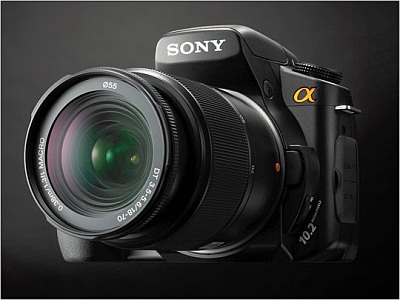 and semi-professional A700, Sony continues to improve their range of photography products and to invest in the development of that segment. In fact, the corporation has been indirectly present in the sphere for years, manufacturing CCD and CMOS chips for digital cameras for other manifacturers. The first Alpha brought about the sceptical smiles of the owners of mirror reflex Konica-Minolta 5D since it was its natural development, possibly made as long ago as before Sony took Konica-Minolta. The new model in the base class - A200 already has the face of a different camera – both as design and make, but anyone who has had the old Minolta matrix will understand that the serious contribution to the invention of this camera belongs again to the engineers of Konica-Minolta. The quality has significantly been improved, the design – softened up and the ergonometry is of higher level. Despite its decreased size A200 reminds strongly of A700 flagman in its design and make, on account of which it cannot be said that A200 is simply an ameliorated version of A100. The two cameras have the same CCD with 10 million effective pixels. Also, the Lens Mount and Flash hot shoe are the same. However, the similarities end here. The new model is much more intuitive as control, handy for operation, has quick and precise AF, wonderful display and improved stabilization system. Combined with the moderate price positioning (700$ with kit lens 18-70) the camera becomes one of the basic alternatives of mirror reflex cameras from low price level.
and semi-professional A700, Sony continues to improve their range of photography products and to invest in the development of that segment. In fact, the corporation has been indirectly present in the sphere for years, manufacturing CCD and CMOS chips for digital cameras for other manifacturers. The first Alpha brought about the sceptical smiles of the owners of mirror reflex Konica-Minolta 5D since it was its natural development, possibly made as long ago as before Sony took Konica-Minolta. The new model in the base class - A200 already has the face of a different camera – both as design and make, but anyone who has had the old Minolta matrix will understand that the serious contribution to the invention of this camera belongs again to the engineers of Konica-Minolta. The quality has significantly been improved, the design – softened up and the ergonometry is of higher level. Despite its decreased size A200 reminds strongly of A700 flagman in its design and make, on account of which it cannot be said that A200 is simply an ameliorated version of A100. The two cameras have the same CCD with 10 million effective pixels. Also, the Lens Mount and Flash hot shoe are the same. However, the similarities end here. The new model is much more intuitive as control, handy for operation, has quick and precise AF, wonderful display and improved stabilization system. Combined with the moderate price positioning (700$ with kit lens 18-70) the camera becomes one of the basic alternatives of mirror reflex cameras from low price level.
1. Design, ergonomy and control:
As Konica-Minolta 5D, the new A200 is characterized with its compact, but still quite heavy body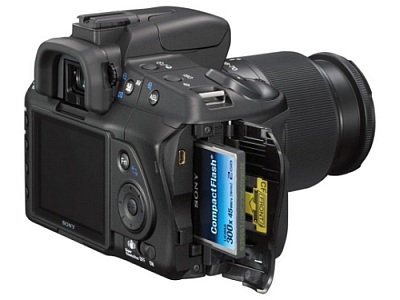 . The heavier body gives the feeling for solidity. This could be a disadvantage for some people, but personally I consider that the higher weight brings more hand stability while taking pictures. The built in unique stabilization system, guarantees picture quality even when taken at very bad light conditions. The design of the camera is linking to the classical forms. The camera fits comfortably to hand, the basic buttons and controlls are located on the right side to the display. The 2.7" TFT-LCD monitor of high resolution and 170° visibility angle has also the role of information display, where the various menu options could be controlled. Like the previous models the display menu turns into vertical direction if the camera is vertically oriented. Of course, the basic photo parameters are controlled without the need to go into the menu. To the left of the display are the buttons for menu browsing, the button, the button for quick deletion and the button for quick picture review. Above them, near the viewfinder is the on/off button. At the right side of the viewfinder there are two buttons – for correction of the exposition and for locking of the exposition. These buttons have the function of zooming up/down the image when in review mode. To the left of the display is the on/off stabilization button and a big multifunctional controller, which is used to control different parameters – adjustment of AF zone, change of the regime for pictures review, navigation of the menu, etc. Above the controller is the fn-button (which could be found at the upper part with KM 5D). Fn – has several functions – adjustment of the AF zone, the focus type, the measurement type, change of the modes and adjustment of the flash light, correction of the white balance and adjustment of the dynamics optimization. In the upper part of the panel, to the left of the prism is the standard selector for different settings – Program, Aperture priority, Shutter Priority, Manual, etc., and to the right are two other buttons – for adjustment of the sensitivity and for serial pictures/self-shutter.
. The heavier body gives the feeling for solidity. This could be a disadvantage for some people, but personally I consider that the higher weight brings more hand stability while taking pictures. The built in unique stabilization system, guarantees picture quality even when taken at very bad light conditions. The design of the camera is linking to the classical forms. The camera fits comfortably to hand, the basic buttons and controlls are located on the right side to the display. The 2.7" TFT-LCD monitor of high resolution and 170° visibility angle has also the role of information display, where the various menu options could be controlled. Like the previous models the display menu turns into vertical direction if the camera is vertically oriented. Of course, the basic photo parameters are controlled without the need to go into the menu. To the left of the display are the buttons for menu browsing, the button, the button for quick deletion and the button for quick picture review. Above them, near the viewfinder is the on/off button. At the right side of the viewfinder there are two buttons – for correction of the exposition and for locking of the exposition. These buttons have the function of zooming up/down the image when in review mode. To the left of the display is the on/off stabilization button and a big multifunctional controller, which is used to control different parameters – adjustment of AF zone, change of the regime for pictures review, navigation of the menu, etc. Above the controller is the fn-button (which could be found at the upper part with KM 5D). Fn – has several functions – adjustment of the AF zone, the focus type, the measurement type, change of the modes and adjustment of the flash light, correction of the white balance and adjustment of the dynamics optimization. In the upper part of the panel, to the left of the prism is the standard selector for different settings – Program, Aperture priority, Shutter Priority, Manual, etc., and to the right are two other buttons – for adjustment of the sensitivity and for serial pictures/self-shutter.
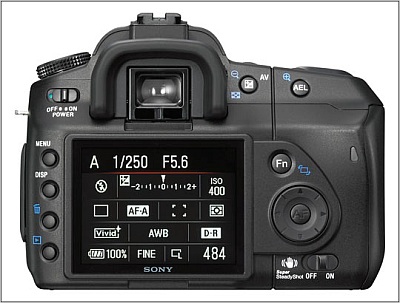
The viewfinder of A200 has magnification x0.83 and 95% coverage. It is light enough and provides good visibility for focusing and taking pictures even at poor light. The indication at the bottom of the display gives information for: compensation and state of the flash light, synchronization, wireless synchronization of the flash light, locking up of the exposition, confirmation for the focus, speed of the shutter, value of the aperture, scale of exposition compensation, counter for the remaining pictures, signal for danger of spreading the picture because of low speed and a quite interesting scale, which shows the stability extent of the camera in your hand. This scale is very useful since one can know when comes the right moment /when the camera is most steady/ to press the button. In fact there is not a big difference with the previous models.
The menu of the camera is easily understandable and generally it enables for the following adjustments: image size, quality and levels of compression – The camera may simultaneously record RAW + JPEG with different levels of compression, picture adjustments /several color adjustments with color changing, sharpness and contrast, and black-and-white image/, noise reduction with high sensitivity, flash light settings, flash light control, deletion, formatting, choice of directory for recording, slide-show, direct print, several custom functions, and other default adjustments, which will not be described in details as they are identical for all cameras.

2.Autofocus and stabilization
A200 has a quick and precise AF. The precision is definitely raised compared to previous models. The camera works well even with wide open appertures. I did many tests with Sony 50/1.4 at F1.4 and I can say that the 1.4 precision is of higher class level than the old model A100. You can see the examples below. The central AF works best and most precisely since it has a cross-type AF sensor. As you already know the models of Sony have unique stabilization system. It was inherited from Konica-Minolta and improved, especially with the lower speeds of the shutter. In this way every owner of such a camera saves thousands of dollars, which would be otherwise spent for lenses with optical stabilization. Further, the stabilization works with other lenses – Sigma and Tamron. According to data of the manufacturer the SSS - (SuperSteadyShot) system allows for taking pictures by up to 8 times lower exposure than normal, which is 3 levels of exposure, i.e. if you take a picture with an lens at focus length of 100mm from hand, the normal speed of the shutter must be 1/100sec. With SSS system turned on you could take pictures at the speed of about 1/10-1/15 sec!!! Taking into account that no special lens are necessary for the purpose, I could say that that is a camera which gives a considerable variety of pictures with no tripod at very low light conditions. Imagine what results you could achieve with the system for optical stabilization and the higher sensitivity, with a Minolta lens 50mm/F1.7 worth not more than 100$. I took 10 pictures at hand with 1/4sec., F1.4 and equal focus length of 75 mm (Sony 50/1.4). The results were not surprising me. In the example below you can see how the image looks without the stabilization system /the upper picture/ and with the stabilization system turned on /the picture below):
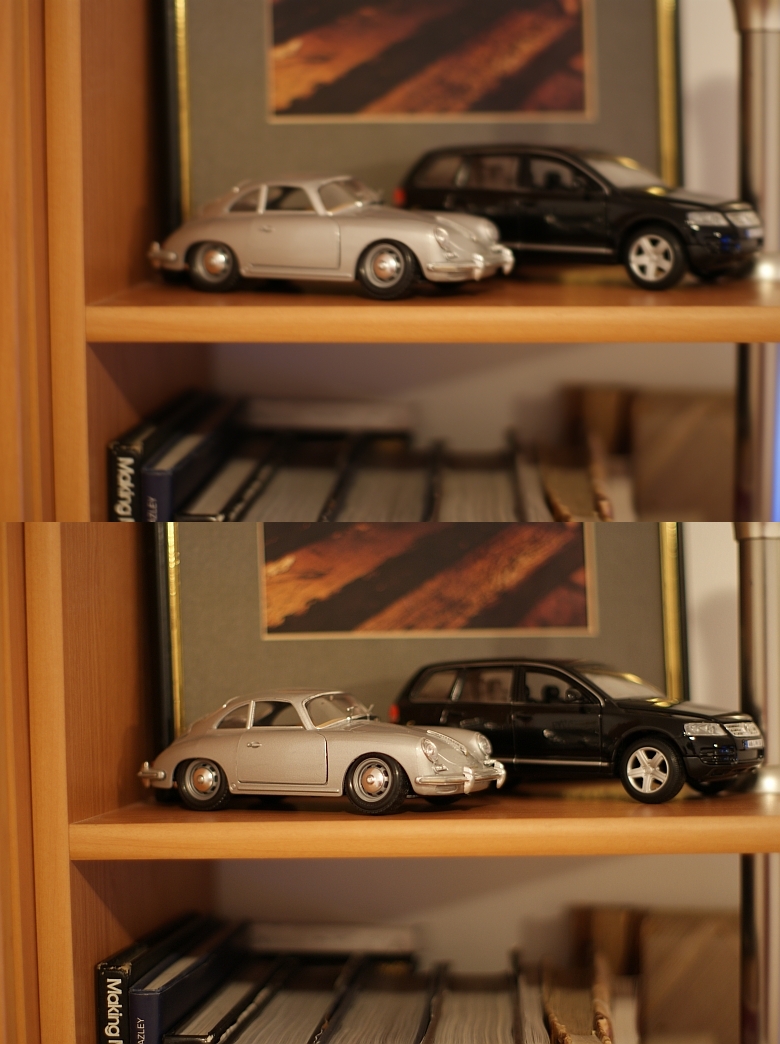
3. Noise and noise-reduction:
The examples below illustrate comparisons between RAW and JPEG at low, but regular light, so that you could be able to assess the influence of the noise and noise reduction onto the image structure. In the examples at the end of the review you will be able to have the pictures in their full format in any sensitivity and different level and type of illumination. At 1600 and 3200 ISO additional noise reduction could be switched on from the menu of the camera, which also is also shown in examples. The segments are of 100%.
The full picture:

Crops 100% 100-400ISO, JPEG, RAW :

Crops 800-3200ISO, JPEG, RAW and JPEG with NR on 1600 & 3200ISO :

The next pictures are also taken at high level of sensitivity and low light. They are directly converted from RAW. You have to click on them in order to open them in full size. 1600ISO, 1/50 sec, F2.5, tungsteen light :
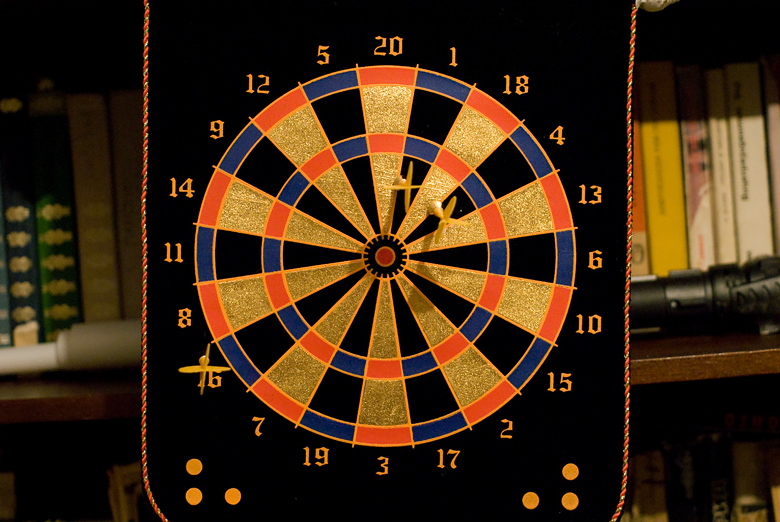
3200ISO, 1/125 sec, F2.5 :

3200ISO, 1/60sec, F1.4 :
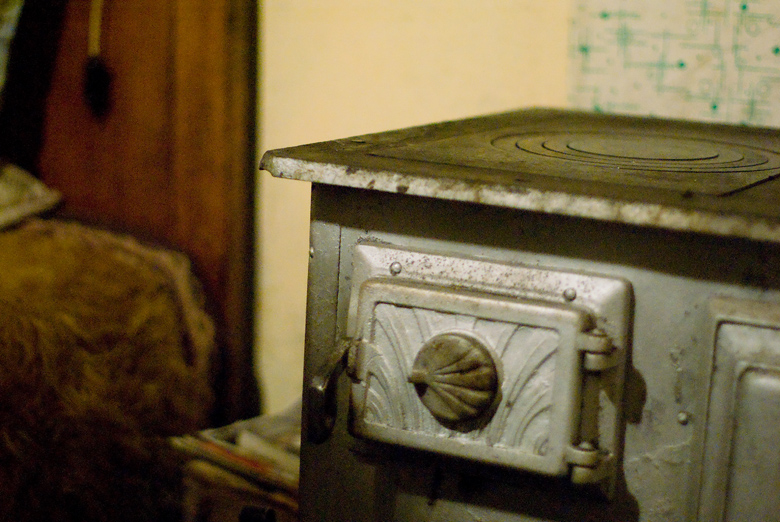
1600iso, 1/50sec, F2.8:

At high level of sensitivity with JPEG there is quite large extent of color noise, especially in the dark zones. Of course, later that could be cleared up with proper software. 3200ISO is suitable only for small extensions of family album type or reporting pictures when the use at lower level of sensitivity is inevitable.
4. RAW or JPEG?
SONY DSLR A200 may record JPEG files at two levels of compression, RAW (about 10MB) or simultaneously RAW and JPEG. It has to be taken into consideration that when the camera works simultaneously in RAW and JPEG mode, the buffer gets exhausted. If you don not have fast card and take pictures consecutively, it is possible to become necessary to wait for 2-3 seconds. The series picture in this case is also limited to three. I recommend that you use a faster CF card possible or fast MemoryStick with adaptor. It is not surprising that much more information could be derived from RAW files and using them is a must especially when taking pictures of landscape and raised dynamics.
RAW, converted with Photoshop CS3, gives the most detailed and finest images with less sharpening. In the example below you could see segments of 100% from the same picture, converted with the camera CS3, Sony IDC SR and JPEG.
Full picture:

Crops 100% as follow : CS3, Sony IDC SR and JPEG:

In the example below you could see the same picture taken at 400ISO, highly overexposed sky and options for restoring details of the sky at JPEG and RAW:
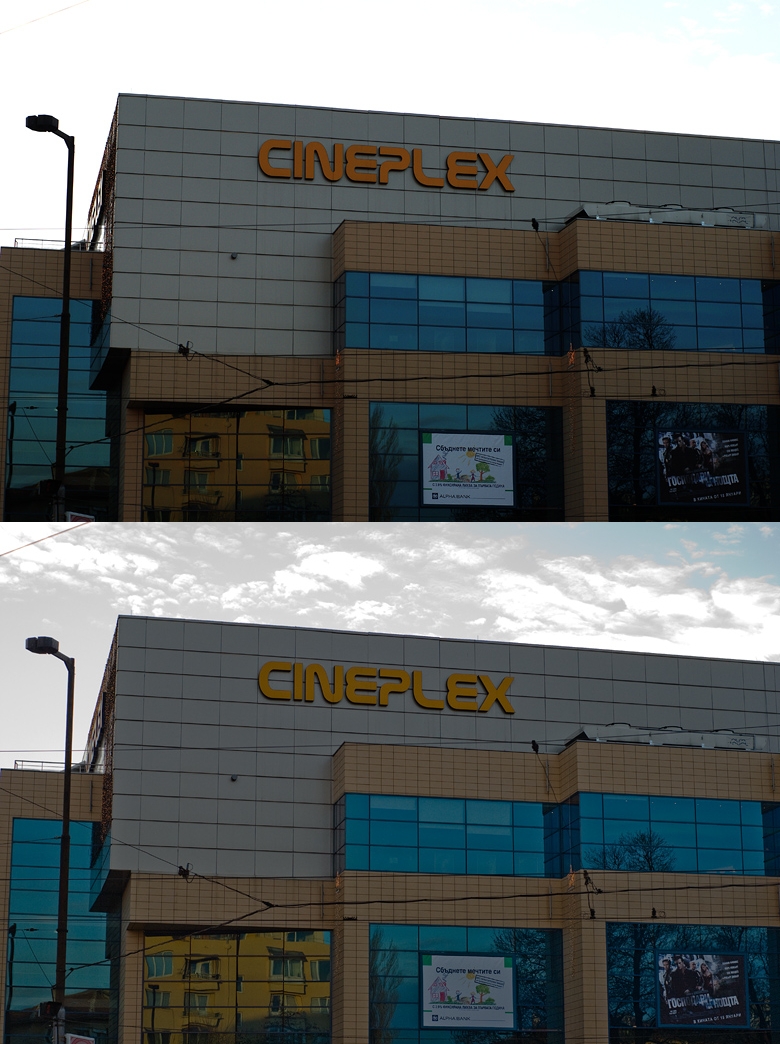
5. Dynamic Range Optimization (DRO):
Traditionally Sony cameras offer software option for extension of the dynamic range at the time of picture taking. This function works much effectively and it is advisable to use it with scenes of higher contrast, for example pictures made in bright sun. Here are some examples of pictures made at JPEG with similar conditions and turned on DRO function. Click onto the picture in order to open it in full size:
100iso, 1/640, F6.3 :

100iso, 1/4000sec, F1.4 :
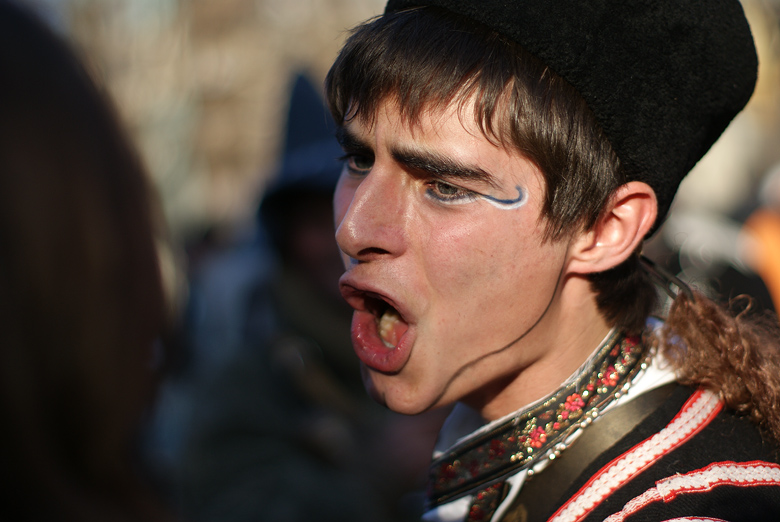
100iso, 1/4000sec, F1.4 :

100iso, 1/2500, F2.8 :

100iso, 1/4000, F2.0:

6. Built in flash
A200 has built in pop-up flash with guide number 12 at 100ISO. It could work in entirely automatic mode, always turned on , slow synchronization and rear flash sync. The availability of stabilization assists the use of slow synchronization regime without the risk of double spread contours so that the result is a well balanced image of combining the flash light and natural light. In the examples below you could see the difference in use of these modes:
Fill-in:

- Slow sinc :
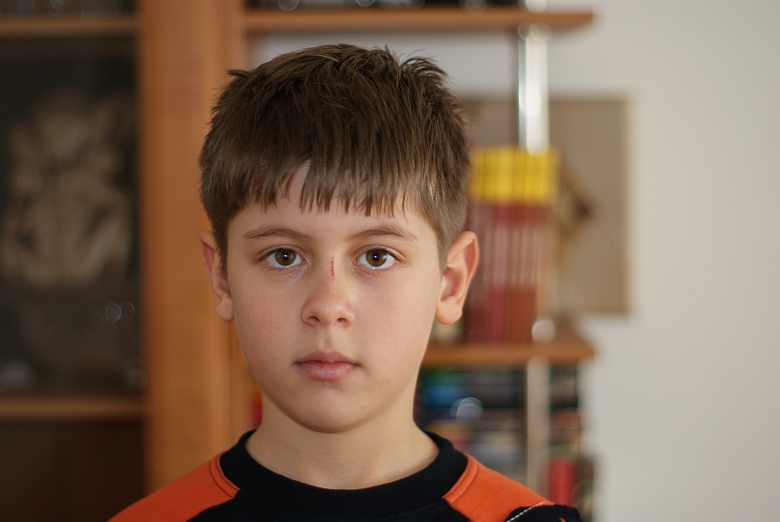
The built in flash light always give consecutive impulses /pre-flash/. I could not find how to exclude the first.
7.Examples of different conditions /click onto the pictures to open them full size/:
100iso, 1/200, F5.0 :
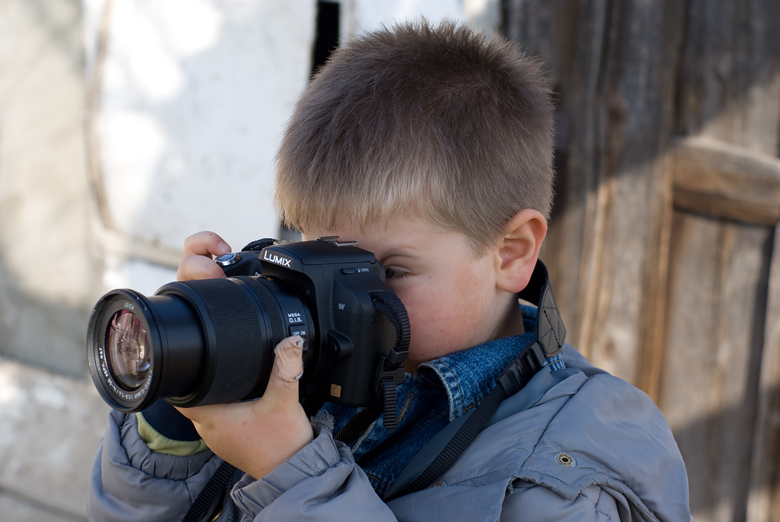
200iso, 1/800, F1.4 :

200ISO, 1/1250, F1.4:

200iso, 1/640sec, F1.4 :

800iso, 1/320sec, F4.0:
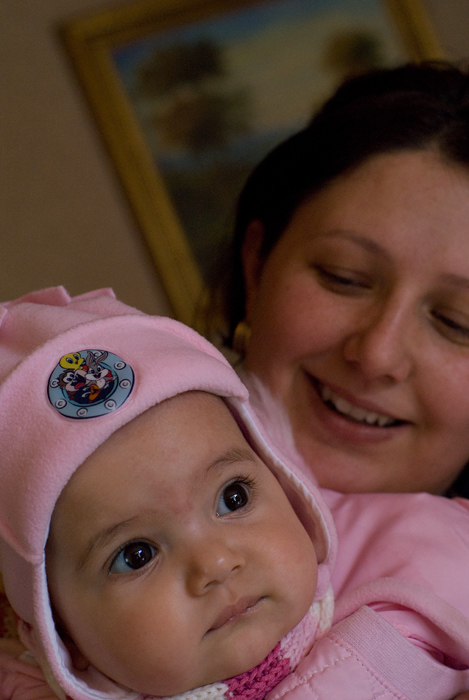
100iso, 1/1250sec, F2.0:

100iso, 1/500sec, F1.4 :
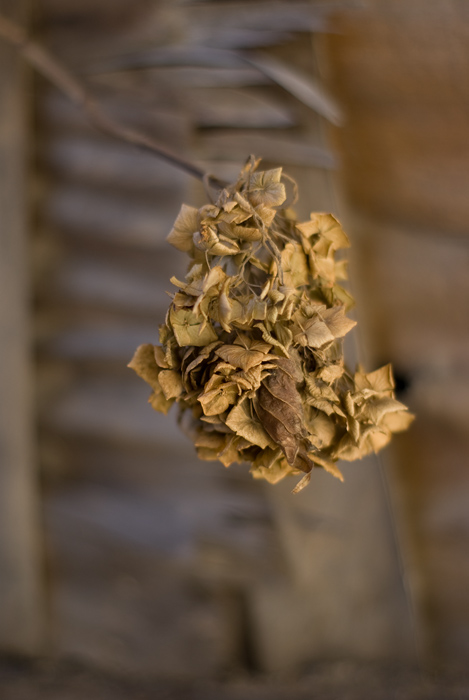
100iso, 1/160sec, F8.0:
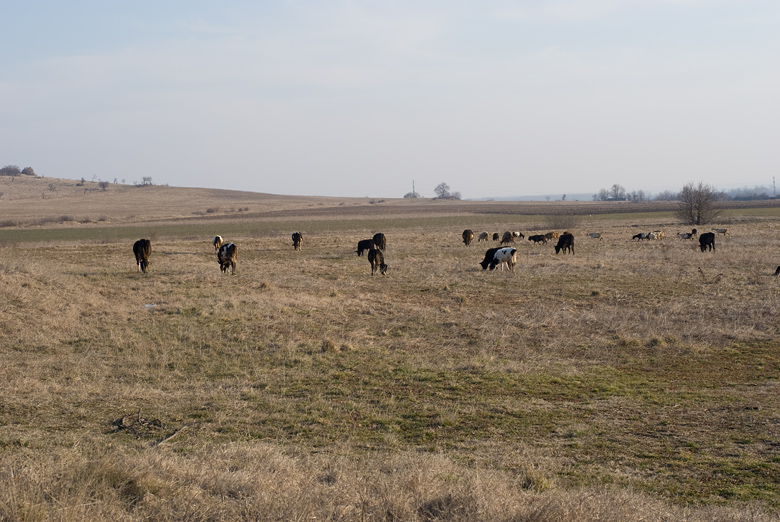
100iso, 1/160sec, F9.0:

800iso, 1/400sec, F1.4 :

100iso, 1/1000, F1.4 :
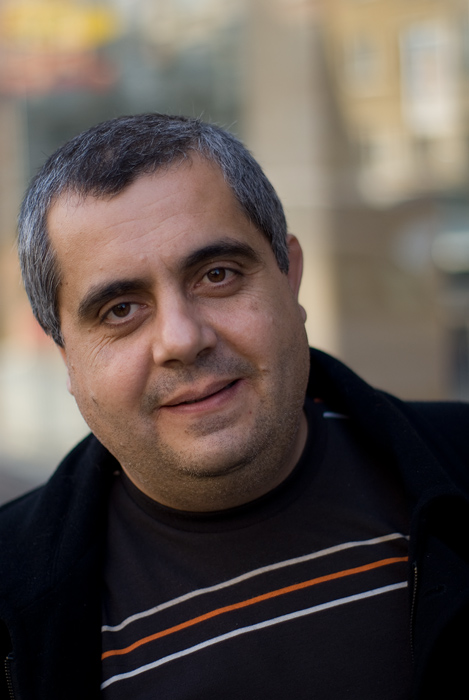
100iso, 1/1000sec, F1.4 :
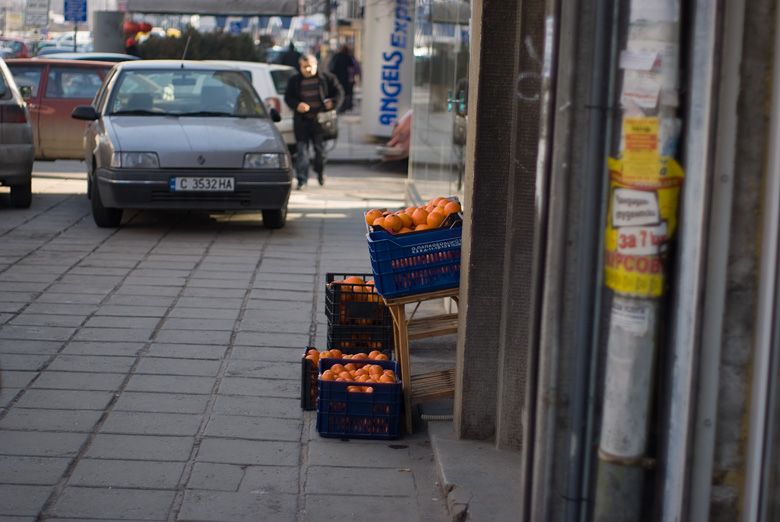
1600iso, 1/40sec, F1.4:
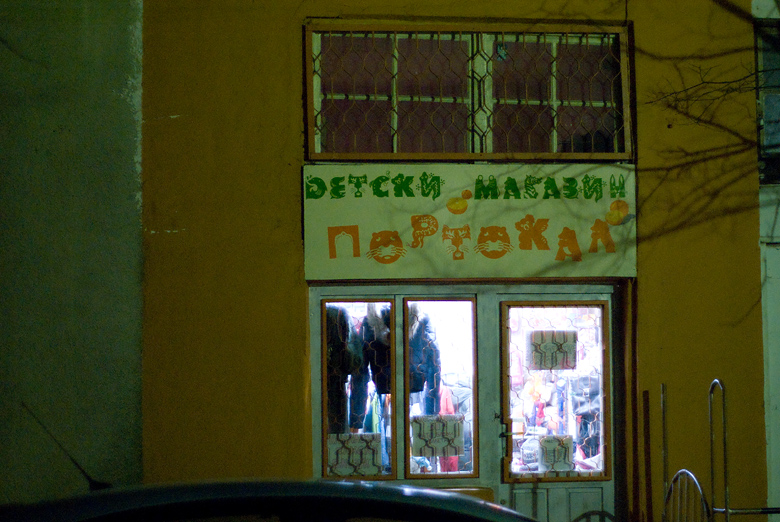
100iso, 1/250, F4.0 :

400iso, 1/250sec, F4.0:

100iso, 1/640 F2.8 :
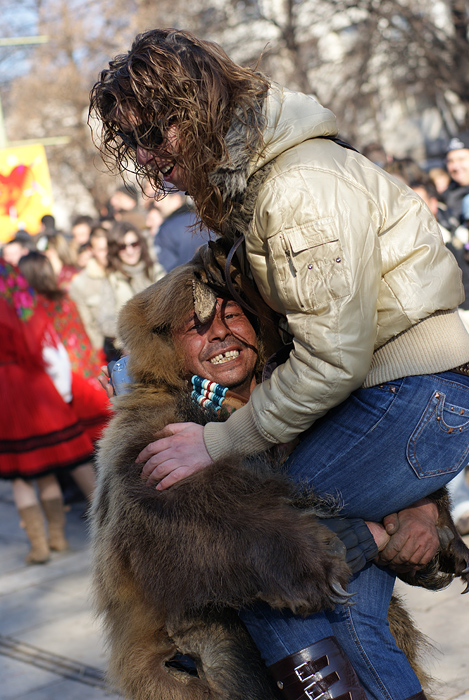
8. Conclusion, advantages and disadvantages
So, A200 is the serial offer of low class digital mirror-reflex cameras. This model could easily tempt advanced amateurs with its attractive price and numerous extras. Speed, ergonomy, handiness, wonderful color reproduction, dynamics and image stabilization – what else could be expected from DSLR at the price of about 700$... Perhaps only a wider range of objectives and accessories. Here are the main advantages and disadvantages, which I established at the time of my 10-days work with the model:
+ Considerably faster and exact AF compared to the previous model A100
+ Option for activating AF by nearing the viewfinder to the eye
+ Faster move of the mirror (short black-out) , quieter shutter
+ Image stabilization with up to 3.5 stops
+ High resolution of the image
+ Indicator of camera stability
+ Dynamic Range Optimization
+ Compact and firm ergonomic body
+ Simultaneous record at RAW and JPEG
+ Considerable detailed display
+ A very good price
- the work of the noise reduction system is not much effective
- The socket of the flash light does not allow working with studio flash light without additional adaptor
- Small buffer, fast card is necessary to minimize the time between the pictures in RAW regime
- no option for adjustment of the stability when working with mechanical objectives
9. Technical specifications:
|
Image Size |
10.2 million effective pixels (3872x2592) |
|
CCD Size |
23.6 x 15.8 mm |
|
Lenses |
Sony Alpha, Minolta A type |
|
LCD Monitor |
2.7" TFT LCD , 230 000 pix, Anti reflection coating |
|
Processor |
BIONZ |
|
Built-in flash |
Built-in pop-up flash , Guide number 12 ( 100ISO ) |
|
Image stabilization |
SSS - Super Steady Shot, Equivalent to 3.5 steps |
|
File Formats |
RAW(12bit), JPEG - 2 levels, RAW+JPEG |
|
ISO |
100-3200ISO, Auto |
|
Metering modes |
40 segment honeycomb, senter and spot |
|
Exposition comp. |
-2.0 / + 2.0 EV |
|
AF |
9 point, EV -1 to 18 (100iso) |
|
Focus modes |
Single-shot, Continious AF, MF, Auto AF |
|
Continuous shooting |
3 fps(up to 6 frames in RAW, JPEG unlimited) |
|
Shooting modes |
Auto, Program AE, Aperture priority, Shutter priority, Manual, Scene |
|
Shutter speed |
30sec to 1/4000sec + Bulb |
|
White Balance |
Auto,Daylight, Cloudy, Shade, Tungsten, Fluorescent, Flash, Kelvin (2500 - 9900 K), Manual |
|
DRO |
Dinamic Range Optimization (OFF, DR, DR+) |
|
Colour space |
sRGB, AdobeRGB |
|
Noise reduction |
Long exposure NR, High ISO NR |
|
Storage |
Compact Flash |
|
Power |
NP-FM500H Lithium-Ion rechargeable battery |
|
Sizes |
131 x 99 x 71mm |
|
Weight |
620g with battery |
B.Bonev'2008


 and semi-professional A700, Sony continues to improve their range of photography products and to invest in the development of that segment. In fact, the corporation has been indirectly present in the sphere for years, manufacturing CCD and CMOS chips for digital cameras for other manifacturers. The first Alpha brought about the sceptical smiles of the owners of mirror reflex Konica-Minolta 5D since it was its natural development, possibly made as long ago as before Sony took Konica-Minolta. The new model in the base class - A200 already has the face of a different camera – both as design and make, but anyone who has had the old Minolta matrix will understand that the serious contribution to the invention of this camera belongs again to the engineers of Konica-Minolta. The quality has significantly been improved, the design – softened up and the ergonometry is of higher level. Despite its decreased size A200 reminds strongly of A700 flagman in its design and make, on account of which it cannot be said that A200 is simply an ameliorated version of A100. The two cameras have the same CCD with 10 million effective pixels. Also, the Lens Mount and Flash hot shoe are the same. However, the similarities end here. The new model is much more intuitive as control, handy for operation, has quick and precise AF, wonderful display and improved stabilization system. Combined with the moderate price positioning (700$ with kit lens 18-70) the camera becomes one of the basic alternatives of mirror reflex cameras from low price level.
and semi-professional A700, Sony continues to improve their range of photography products and to invest in the development of that segment. In fact, the corporation has been indirectly present in the sphere for years, manufacturing CCD and CMOS chips for digital cameras for other manifacturers. The first Alpha brought about the sceptical smiles of the owners of mirror reflex Konica-Minolta 5D since it was its natural development, possibly made as long ago as before Sony took Konica-Minolta. The new model in the base class - A200 already has the face of a different camera – both as design and make, but anyone who has had the old Minolta matrix will understand that the serious contribution to the invention of this camera belongs again to the engineers of Konica-Minolta. The quality has significantly been improved, the design – softened up and the ergonometry is of higher level. Despite its decreased size A200 reminds strongly of A700 flagman in its design and make, on account of which it cannot be said that A200 is simply an ameliorated version of A100. The two cameras have the same CCD with 10 million effective pixels. Also, the Lens Mount and Flash hot shoe are the same. However, the similarities end here. The new model is much more intuitive as control, handy for operation, has quick and precise AF, wonderful display and improved stabilization system. Combined with the moderate price positioning (700$ with kit lens 18-70) the camera becomes one of the basic alternatives of mirror reflex cameras from low price level. . The heavier body gives the feeling for solidity. This could be a disadvantage for some people, but personally I consider that the higher weight brings more hand stability while taking pictures. The built in unique stabilization system, guarantees picture quality even when taken at very bad light conditions. The design of the camera is linking to the classical forms. The camera fits comfortably to hand, the basic buttons and controlls are located on the right side to the display. The 2.7" TFT-LCD monitor of high resolution and 170° visibility angle has also the role of information display, where the various menu options could be controlled. Like the previous models the display menu turns into vertical direction if the camera is vertically oriented. Of course, the basic photo parameters are controlled without the need to go into the menu. To the left of the display are the buttons for menu browsing, the button, the button for quick deletion and the button for quick picture review. Above them, near the viewfinder is the on/off button. At the right side of the viewfinder there are two buttons – for correction of the exposition and for locking of the exposition. These buttons have the function of zooming up/down the image when in review mode. To the left of the display is the on/off stabilization button and a big multifunctional controller, which is used to control different parameters – adjustment of AF zone, change of the regime for pictures review, navigation of the menu, etc. Above the controller is the fn-button (which could be found at the upper part with KM 5D). Fn – has several functions – adjustment of the AF zone, the focus type, the measurement type, change of the modes and adjustment of the flash light, correction of the white balance and adjustment of the dynamics optimization. In the upper part of the panel, to the left of the prism is the standard selector for different settings – Program, Aperture priority, Shutter Priority, Manual, etc., and to the right are two other buttons – for adjustment of the sensitivity and for serial pictures/self-shutter.
. The heavier body gives the feeling for solidity. This could be a disadvantage for some people, but personally I consider that the higher weight brings more hand stability while taking pictures. The built in unique stabilization system, guarantees picture quality even when taken at very bad light conditions. The design of the camera is linking to the classical forms. The camera fits comfortably to hand, the basic buttons and controlls are located on the right side to the display. The 2.7" TFT-LCD monitor of high resolution and 170° visibility angle has also the role of information display, where the various menu options could be controlled. Like the previous models the display menu turns into vertical direction if the camera is vertically oriented. Of course, the basic photo parameters are controlled without the need to go into the menu. To the left of the display are the buttons for menu browsing, the button, the button for quick deletion and the button for quick picture review. Above them, near the viewfinder is the on/off button. At the right side of the viewfinder there are two buttons – for correction of the exposition and for locking of the exposition. These buttons have the function of zooming up/down the image when in review mode. To the left of the display is the on/off stabilization button and a big multifunctional controller, which is used to control different parameters – adjustment of AF zone, change of the regime for pictures review, navigation of the menu, etc. Above the controller is the fn-button (which could be found at the upper part with KM 5D). Fn – has several functions – adjustment of the AF zone, the focus type, the measurement type, change of the modes and adjustment of the flash light, correction of the white balance and adjustment of the dynamics optimization. In the upper part of the panel, to the left of the prism is the standard selector for different settings – Program, Aperture priority, Shutter Priority, Manual, etc., and to the right are two other buttons – for adjustment of the sensitivity and for serial pictures/self-shutter.



































